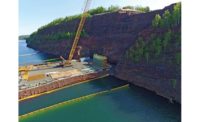Trunk Highway 53 Relocation
Virginia, Minn.
Best Project and Award of Merit, Highway/Bridge
Owner: Minnesota Dept. of Transportation-District 1
General Contractor/Construction Manager: Kiewit Infrastructure Co.
Lead Design Firm/Structural Engineer: Parsons
Civil Engineer: SEH Inc.
Key Subcontractors: All Phase Contracting; Alpine Steel Inc. (JD Steel); Badger Daylighting Corp.; Barr Engineering Co.; Braun Intertec Corp.
Relocated to allow iron ore extraction under the existing alignment, the new 3.2-mile Route 53 includes Minnesota’s tallest bridge—a 1,132-ft-long, 92-ft-wide steel structure rising 200 ft above an inactive, water-filled mine pit that serves as a regional source of drinking water.
Challenged to meet an aggressive 30-month design and construction schedule, the project team identified work that could be accomplished prior to completion of permitting and final design. The structural steel package was completed in less than 45 days from the start of preconstruction. More than 5,000 tons of structural steel were procured ahead of environmental permit completion.
A difficult jobsite, bitterly cold winter working conditions and time pressure from an aggressive schedule all combined to make safety a challenge for the project.
Any one of these factors might have disrupted the Kiewit-led team’s efforts to relocate the roadway in Minnesota’s far north. When finishing touches were completed on the $168-million project in October 2017, the project team had tallied 600,000 worker-hours with neither a lost-time injury nor a recordable incident.
The relocation, which included a new 1,132-ft-long bridge across a water-filled former iron ore mine pit, had to deal with near-vertical rock face walls that limited access for workers and equipment. Tasks included blasting, installing foundations through mine waste rubble to depths of up to 176 ft below the pit floor and crane picks of more than 750,000 lb. The accelerated 30-month design and construction schedule would also expose workers to harsh working conditions in temperatures as low as minus 40° F.
These challenges required establishing a strong safety culture and sustaining it throughout the project. Partnering with OSHA, MnDOT and subcontractors, Kiewit crafted a project-wide program that also addressed issues such as fall protection, dropped objects, trench and excavation, utilities and night work.
A pocket-size mini hazard analysis booklet proved a handy reference guide for workers to double-check their preparations for carrying out tasks.
It wasn’t just staff and trade workers whose safety was considered. The inactive mine pit is a reservoir for two nearby municipal drinking water systems, so Kiewit’s safety plan had to safeguard water quality.
MnDOT has since adopted the hazard analysis booklet and several other program elements for its maintenance operations.








Post a comment to this article
Report Abusive Comment